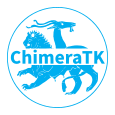 |
ChimeraTK-DeviceAccess 03.25.00
|
 |
ChimeraTK-DeviceAccess 03.25.00
|
To use the ChimeraTK::Device class you need a so called "device map" file (dmap file).
It is created manually and contains information which devices are used in your application. More information can be found on the page about Device Mapping.
For the beinning all you need is the alias which identifies the device. In the example.dmap file there is just one entry: MY_DEVICE
Registers are accessed by so called accessors. The accessors contain a buffer which stores the data which is read from or written to the hardware using read() and write() functions. When not reading or writing you can efficiently access or modify the content at will, because it is modifying the internal buffer and not talking to the hardware.
In this basic example are using a register which holds one value. A single value is a scalar, so we are using the ScalarRegisterAccessor. Like all accessors, it is templated to a simple (user) data type and automatically does a data conversion to this type, if needed. The ScalarRegisterAccessor behaves just like the simple data type it represents, so you can just assign to it, add, subtact, multiply or divide it, print it, ... Usually you don't allocate a variable and copy the accessor content to it (which would be really inefficient in case of large data arrays), but just use the accessor.
Although the initialisation syntax of _temperatureSetPoint in the example above uses the equals sign, this is calling the copy constructor. Accessors intentionally don't have assignment operators (see Why do RegisterAccessors not have an assignment operator for other RegisterAccessors?).
If you want to initialise an accessor which is already created, use replace(). You need this for instance if the accessor is a class member and has already been instantiated before you call devcie.getXXXAccessor() in the constructor.
Next topic: Multi Value Registers (1D Register Accessors)